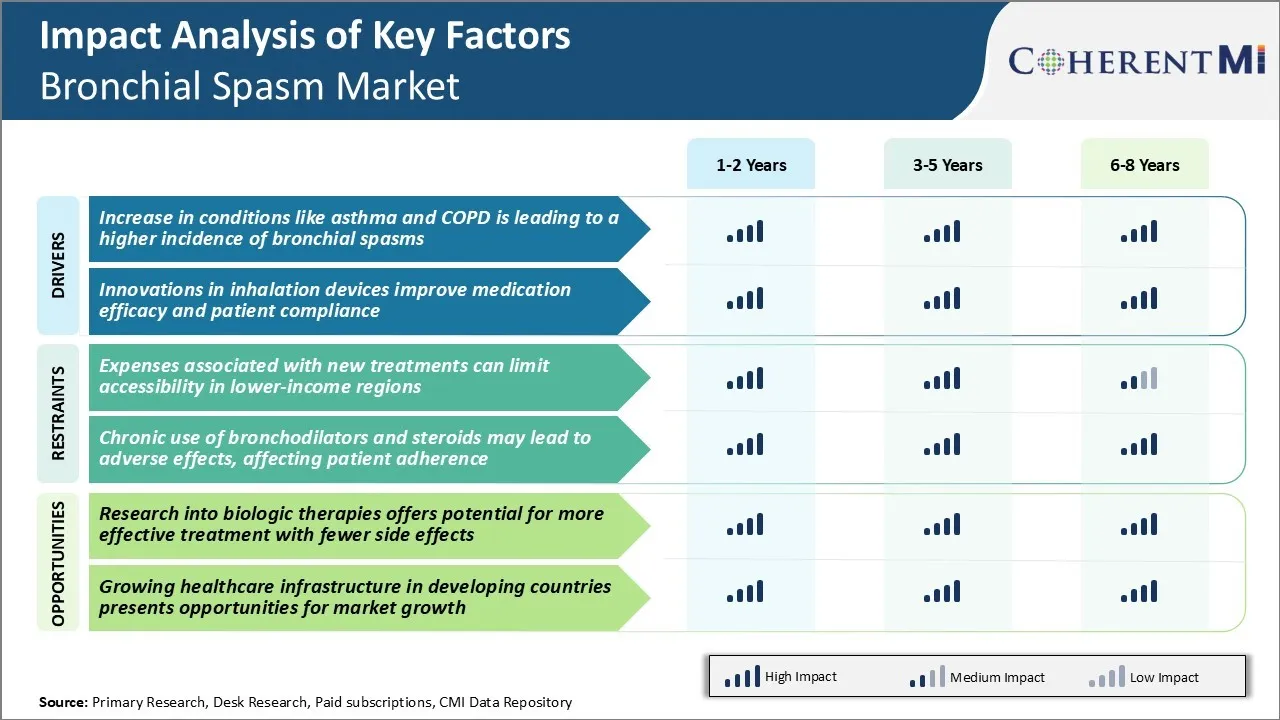Bronchial Spasm Market Trends
Market Driver - Increase in Conditions Like Asthma and COPD is Leading to a Higher Incidence of Bronchial Spasms
According to recent studies, around 339 million people worldwide suffer from asthma, while over 329 million have chronic obstructive pulmonary disease (COPD). These inflammatory lung diseases often lead to narrowing and blockage of the airways due to the bronchoconstriction of muscles. Bronchial spasms, also known as bronchospasms, are spontaneous contractions of the muscles in the walls of the bronchial tubes, which results in the obstruction of airflow.
The rising healthcare expenditures and improving access to diagnosis and treatment in developing Asian countries have also escalated the demand for bronchial spasm drugs. Furthermore, aging population profiles in North America and Europe imply a growing risk of respiratory illnesses. Older individuals suffering from recurrent or chronic respiratory diseases have a higher propensity of bronchial spasms. The presence of co-morbid conditions like heart diseases also aggravates bronchial spasms in elderly patients.
However, complete resolution of symptoms remains elusive for most patients due to the recurring nature of the underlying conditions. Therefore, long-term control medications for prevention and relief of bronchial spasms will continue to be prescribed. The widening patient pools of asthma and COPD and growing clinical emphasis on optimized bronchoconstriction management are fueling the demand for bronchial spasm pharmaceuticals globally.
Market Driver - Innovations in Inhalation Devices Improve Medication Efficacy and Patient Compliance
Inhalation has proven to be the most effective route of administration for bronchial spasm drugs due to its direct delivery of medications to the lungs. Technological advances in drug development along with novel propellant-free inhaler designs have augmented treatment successes in recent years.
Metered dose inhalers, dry powder inhalers and nebulizers utilizing innovative formulations are ensuring deeper lung penetration and higher drug concentrations for quick relief of bronchial spasms. Additionally, user-friendly features such as easy-breath activation and dose counter integration in new-age inhalers have greatly elevated patient comfort levels and compliance to pharmacotherapy regimens.
Recognizing the critical relationship between proper inhalation technique and therapeutic outcomes, device developers are focusing on fool-proof, intuitive functionalities. A number of smart inhalers are being launched which can record usage data and send reminders. Such connected devices aided by mobile health apps and respiratory monitoring sensors allow for remote monitoring and personalized advice from physicians.
Partnerships between device manufacturers and digital therapeutics companies are further strengthening medication adherence through remote therapeutic support on mobile platforms. Furthermore, single-dose dry powder inhalers dispensing month-long supplies are improving adherence to maintenance treatment schedules for long-term control.

Market Challenge - Expenses Associated with New Treatments Can Limit Accessibility in Lower-Income Regions
One of the major challenges facing the bronchial spasm market is the expenses associated with new treatments, which can limit their accessibility in lower-income regions. Developing and bringing novel drug therapies to market requires massive investments in clinical research and regulatory approval processes.
As a result, the costs of these new drugs tend to be quite high once launched commercially. For populations in developing countries and underserved rural areas, these high drug prices can put life-changing treatments out of reach. Even in developed markets like the United States, the affordability of new specialty medications is a major public policy concern, as not all patients have comprehensive healthcare coverage or can afford high deductibles and co-insurance rates.
Unless generic alternatives emerge or governments take steps to subsidize costs, a sizable portion of patients worldwide may lack access to the latest medical innovations for bronchial spasms simply due to financial limitations. This disproportionately impacts those most in need, exacerbating global health inequities.
Market Opportunity - Potential of Biologic Therapies
One opportunity within the bronchial spasm market lies in ongoing research into biologic therapies. Scientists are working to develop more effective drugs that target the underlying inflammatory processes driving bronchial contractions, rather than just addressing symptom relief like many existing treatment options. Biologics derived from antibodies or cellular therapies offer the prospect of more precisely regulating the human immune system's misguided response in allergic asthma.
If successful, these new biologic treatments could provide corticosteroid-sparing options with fewer side effects compared to traditional bronchodilators and inhaled corticosteroids. Advances in biomanufacturing are also helping to drive down costs and facilitate greater accessibility of these highly customized medications over time. As the mechanistic understanding of bronchial spasms continues to evolve, research into biologics holds great potential to transform disease management and outcomes for affected patients worldwide.